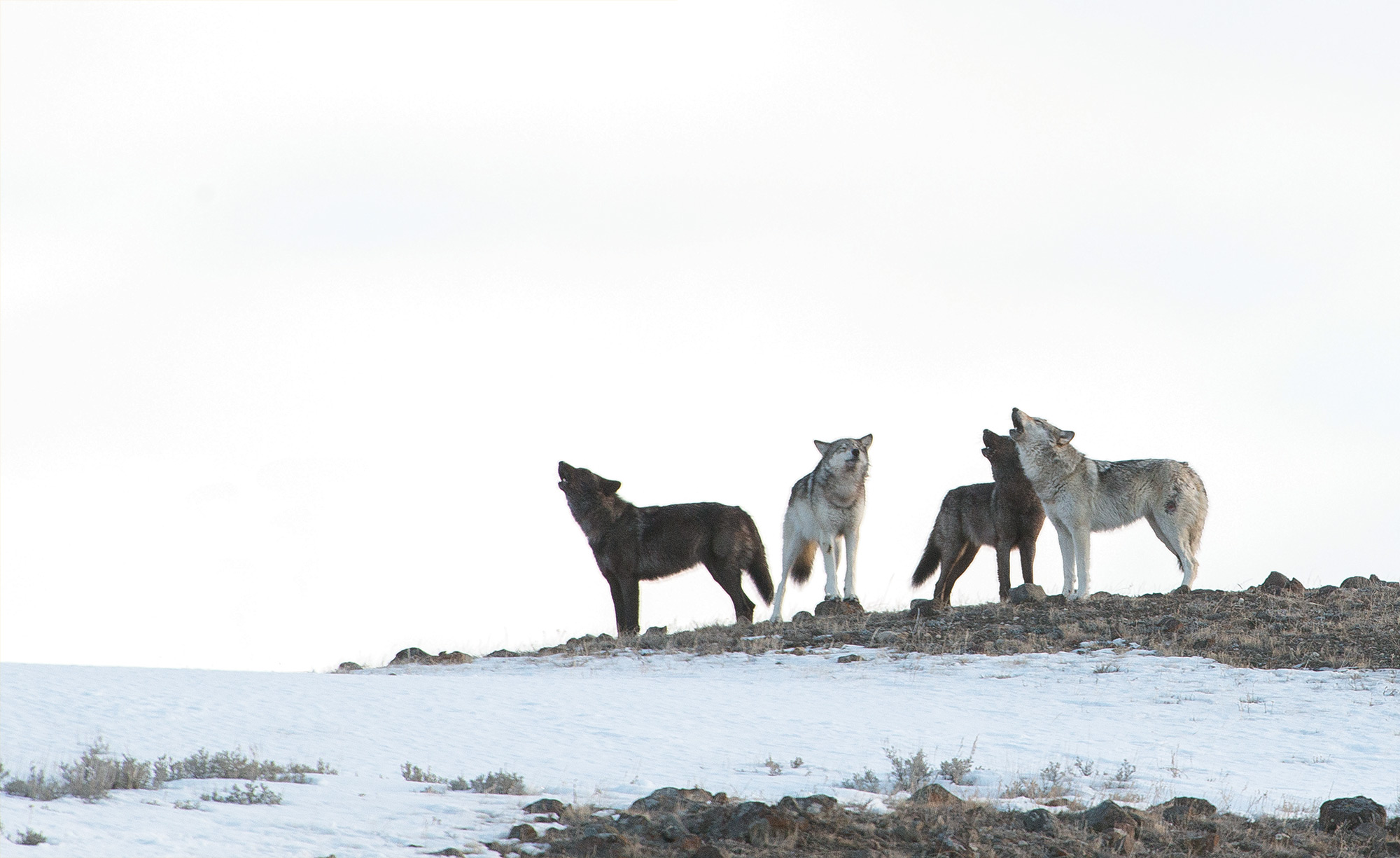
02 Oct Trying to Balance Wolves
NO ONE KNOWS FOR SURE what brought down the 1,800-pound bison bull. The strapping behemoth was dead, its mortal end likely caused by canid fangs applied to jugular vein. When Doug Smith arrived on the scene during an August day in Yellowstone’s Lamar Valley, a scrum for dibs was already ensuing between two of the national park’s most formidable and charismatic predators hungry for a meal.
As Smith describes it, a sow grizzly bear and triplet cubs had moved in first on the fresh carcass. Rising on her haunches, whiffing the air, the mother bruin took note of a 600-pound male grizzly rapidly closing in across the sagebrush. Circling, too, were gray wolves — members of the Junction Peak pack — howling and yelping as they dodged the bears and sent ravens and a pair of bald eagles scattering.
The commotion, as expected, attracted a large crowd of human onlookers along the road 100 yards distant. Even Smith, Yellowstone’s senior wolf biologist, couldn’t help but marvel at the scene.
“This,” he thought to himself, “is the picture of wildness that America’s first national park is supposed to be in the 21st century.” In fact, considering that all three species — bison, grizzlies and lobos — had been nearly annihilated in the Lower 48 states, he called their convergence a miracle.
Remembering a brutally cold day in January two decades earlier, Smith started to feel butterflies in his gut. One of the grandest achievements in U.S. wildlife conservation history, the restoration of wolves to the iconic ecosystem from which they had been exterminated, almost didn’t happen.
In 1995, the then-young field man had walked behind a group of notable bureaucrats, which included Interior Secretary Bruce Babbitt, the late U.S. Fish and Wildlife Service Director Mollie Beattie and Yellowstone Superintendent Michael V. Finley, as they ceremoniously carried crates of Canadian wolves to holding pens prior to their release in the Lamar Valley. It ended a 60-year absence for Canis lupus.
Some 31 wolves were turned loose into Yellowstone and another 35 into wilderness areas of central Idaho over the course of two successive winters. Between then and now, offspring of those wolves have flourished in the Northern Rockies and begun to re-colonize Washington, Oregon and California, surpassing even the wildest expectations of the architects who brought them back. Dispersers have showed up on the North Rim of the Grand Canyon in Arizona, Utah and Colorado.
“Bringing the wolves back to Yellowstone was the high point of my years at Interior,” Babbitt told me recently. “My personal pilgrimage toward that moment was long in the making, for I grew up in a ranching family in Arizona when wolves were viewed as red-eyed devils. Then one summer, while working in the forests on a fire crew, I happened to read Leopold’s green fire essay.”
Reflecting on how his thinking shifted, he notes, “It was one of those transforming moments, where I began to understand that wolves, like fire, were essential for us and for the natural world. Even then, I could not imagine I would live to see wolves return, much less actually take part in the process, along with many dedicated advocates and public officials, of bringing Leopold’s dream to reality.”
The U.S. is a country that loves commemorating milestones. Last winter, the 20th anniversary of wolf restoration in the Greater Yellowstone Ecosystem presented a moment for profound reflection. And it is bolstered in 2016 by the 100th anniversary of the National Park Service.
The events that led up to wolf reintroduction were both dramatic and controversial. In the months right before it happened, Renee Askins, founder of the Jackson Hole, Wyoming-based Wolf Fund, received mailed death threats and nasty letters in response to her wolf advocacy. She published some of the hate mail in her book, Shadow Mountain: A Memoir of Wolves, a Woman and the Wild.
Yellowstone interpretive ranger Norman Bishop, who went on the stump for the Park Service trying to educate the public about the ecological benefits of wolves, had politicians in the region calling for him to be fired. Why is there such vehement animus directed toward wolves even by people who have no contact with them?
Mike Jimenez, the U.S. Fish and Wildlife Service’s current wolf coordinator for the Northern Rockies, says, “Those who tried to stand in the way weren’t just saying no to wolves. They were saying, ‘Hell, no! Not in this lifetime.’ And some still aren’t very happy about it.”
Twenty-plus years on, the subject is still emotionally charged. Robert Fanning, who was involved with a group called Friends of the Northern Yellowstone Elk Herd and later tried to run for governor, called wolf reintroduction “the greatest wildlife disaster” of the last century. He claimed — erroneously — that wolves would devastate all prey species and that Yellowstone would turn into a “biological wasteland.”
Hastened by the Internet age, reports of death threat exchanges between “wolf lovers” and “wolf haters” are common. And yet there’s an undeniable silver lining: Wolves, against long odds, are again embedded in the tapestry of the Wild West. It’s a profound thing to bring back a species like the lobo.
Just as his retired predecessor Ed Bangs at the Fish and Wildlife Service, Jimenez has been on the front lines, spending his entire professional career — nearly 30 years — studying wolves as a government biologist. Now based in Missoula, Montana, his connection to the animals began in the mid-1980s when researchers were tracking wolves that naturally dispersed southward out of Canada into Glacier National Park.
“I remember when there was pretty much no wolves in the Rockies south of Canada. If you had told me 20 years ago that we would have around 320 packs and somewhere approaching 2,000 wolves in the West in 2015 to 2016, I wouldn’t have believed you,” he says.
During the last decade, wolves have wandered to the outskirts of Jackson, and left tracks in the snow on the edge of Montana towns including Big Sky, West Yellowstone, Livingston and the Bozeman suburbs; they rarely cause trouble but their faint howls heard on the breeze add to their mystique.
“Oh, wolves are around, and they will follow wildlife — their elk, moose and deer prey — that dwell in residential subdivisions, but let’s be clear: We should not have expectations that it’s OK for wolves to inhabit in close quarters the places where people live,” Jimenez says, noting that he caught flak for lethally removing a few wolves that were spending time in the outskirts of Jackson.
“Humans and wolves can do fine coexisting — at a distance. Wolves, for the most part, don’t represent a danger to us, but they are wild animals and should be treated as such,” he adds. A couple of salient facts: No person in the Lower 48 has ever been attacked and killed by a healthy wild wolf, and no farmer or rancher has been run out of business because of lobo attacks on their livestock.
=
Renee Askins earned a place in the hearts of many as “the wolf lady” of Yellowstone’s modern age. An ardent conservationist, she founded the Wolf Fund in 1986. Its singular ad hoc mission was to bring wolves back to Yellowstone. She promised the Wolf Fund would close the second wolves were re-established.
Recalling a long list of characters who played pivotal roles in making reintroduction happen, Askins names several park officials, including former superintendents Bob Barbee and Finley, science chief John Varley, resource specialist Wayne Brewster, ranger Bishop and wolf manager Mike Phillips (now a Montana state senator and director of the Turner Endangered Species Fund). They risked their jobs by advocating for wolves despite fierce political pressure, as well as orders that they couldn’t use tax dollars to promote wolf reintroduction — orders they defied. Another hero was the late William Penn Mott, director of the National Park Service under President Ronald Reagan, and two Missoula-based conservationists, Hank Fischer of Defenders of Wildlife and Tom France of the National Wildlife Federation.
Bishop says a key contribution came from conservationists Pat Tucker and Bruce Weide who brought a wild wolf named Kuane to hundreds of schools nationwide, demythologizing wolves and making them a cause célèbre.
Following completion of a lengthy environmental impact statement, hundreds of contentious public meetings, and millions of public comments submitted — the vast majority supporting reintroduction — the final pieces involved finding wolves in western Canada to transplant, and then navigating a gauntlet of legal challenges.
Askins was there at Roosevelt Arch in 1995 to welcome wolves being ferried into the park, the homecoming accompanied by an armed escort from law enforcement warned about possible violence from troublemakers.
“My favorite moment was watching all the Gardiner school kids, festooned in vibrant-colored mittens, rainbow snow boots, their scarves fluttering like bright prayer flags, as they gathered along the roadside to wave wolves in,” Askins recalls. “I was told there were some displeased teachers that had resisted, but the kids charged out to line the route, oblivious to any adult trepidation.”
Like biologist Smith, she was afraid that a last-minute court ruling would delay reintroduction or halt it entirely. Had the opportunity been lost, there might not be wolves in Yellowstone today.
Many worried that wolves, confined to small travel cages, might not survive the journey or delays. There were some exceptionally tense hours while the Farm Bureau sued for an injunction to prevent wolves from being released out of their portable kennels into the park holding pens. “Secretary of Interior Bruce Babbitt, there for the celebration, found himself speculating to the press about whether Yellowstone’s first wolves would arrive not in kennels but coffins,” Askins recalls.
That didn’t happen. Approval from an Interior department attorney, upheld by a federal judge, cleared the way over protests and predictions that the Western way of life was about to collapse. That didn’t happen either.
At first, wolves lived and thrived mostly inside the park and remote corners of the region away from people; but Yellowstone isn’t a zoo, nor does it have fences. L. David Mech, considered America’s foremost wolf authority and best known for fieldwork on Isle Royale in Lake Superior and for overseeing the recovery of wolves in Minnesota, knew the real test would come when wolves left the park where they had safe haven. It didn’t take long. In late April 1995, only weeks after the wolves were turned loose, Chad McKittrick of Red Lodge, Montana, poached a wandering wolf to have as a trophy then bragged about it believing he would be treated as a hero. He wasn’t. A federal judge sentenced him to six months in prison, curbing the enthusiasm of would-be vigilantes.
“There were several harrowing moments the public didn’t realize,” Bishop explains. “It wasn’t like just pulling one camel through the eye of a needle. It was pulling several camels through the eyes of several needles, each one essential for it to move forward.” He shares the story of how, just prior to the second part of reintroduction moving forward, during the capture of a second pool of wolves in Canada, U.S. Senator Conrad Burns diverted $300,000 away from the budget, clearly hoping to stop reintroduction in its tracks.
“Suzanne Stone [with Defenders of Wildlife] beat the bushes and came up with funds that enabled us to proceed. If different heroes hadn’t stepped up and made a difference at key moments, we would not have wolves here today,” Bishop says.
The park’s 31 new colonizers multiplied to more than four times that number in the first few years. Within half a decade, wolves began inhabiting places where rural people and their livestock live. How wildlife are managed in the national park — where hunting and trapping isn’t allowed, there is no livestock, and preservation is the objective — is very different from the reality outside Yellowstone. “Shoot, shovel and shut-up” is a code still embraced by people who despise wolves, resent the federal government and would love to make the animals go away.
“My colleagues with other agencies jokingly say that I work in a wildlife country club,” Yellowstone’s Smith says. “But it’s not easy being a wolf no matter where you live.”
“I agree with Doug that there is tremendous value to having places like Yellowstone where wildlife doesn’t have to be subjected to constant and, in some cases, heavy-handed human management and harassment,” Mech says. “But the fact is, the majority of terrain inhabited by wolves in the West is found outside national parks. There, wolves fall under some form of management. The question is, what kind?”
In Montana, an outspoken foe of wolves posted instructions for how to poison lobos on his website, conduct that some wolf advocates say is akin to promoting eco-terrorism. In Idaho, a legislator told Suzanne Stone in Boise that she shouldn’t testify at a wolf hearing in the state capitol because harm might come to her. In autumn 2013, a Wyoming hunter shot a wolf in the “predator zone” south of Jackson where it is legal to do so, strapped the carcass to the top of his vehicle, and then parked along the community’s iconic Town Square, with its elk antler arches, as a defiant gesture against wolf conservationists.
Wolves have been removed from the list of animals protected by the Endangered Species Act (a process called “delisting”) a couple of times, with court challenges restoring protection. In 2011, not long after wolves were removed from protection the first time, a group of Wyomingites trespassed on a private ranch, used snowmobiles to chase down wolves, and killed them. Shortly afterward, they were given federal protection again. They came off the list in Montana and Idaho later that year but, for the moment, remain listed in Wyoming.
No state has a more questionable policy toward wolf management than Wyoming. Rules put in place that classify wolves as “predators” allow them to be killed in over 80 percent of the state at any time of day, by any means and for any reason, whether they represent a threat to livestock or not.
Bullying flows both ways. Hunters have been harassed and threatened with harm. A group called the Yellowstone Wolf Patrol vowed to disrupt legal hunts of wolves in the Absaroka-Beartooth Wilderness of Montana after popular Yellowstone research wolves were gunned down the moment they left the park. “We are not opposed to Montana residents filling their freezers with elk, but the wolves were here first and deserve protection from recreational killing,” said patrol member Julie Henry.
In the West, the human perception of wolves is different from that in Minnesota (my home state), where they were never entirely extirpated, and Wisconsin and Michigan where the population rebuilt itself from wolves roaming in. In the West, wolves are regarded as direct competitors.
“You don’t have to agree with them, but it’s important to understand the perception that people out here have,” Jimenez says. ”Wolves were completely gone and then brought back into places where they weren’t wanted. Getting rid of wolves initially was a source of cultural pride. I often hear stories from people who claim it was their grandfather who killed the last wild wolf in their state. They resent the federal government because we went to Canada, got wolves and dumped them in their backyards. They’re angry with environmentalists because they pushed to make reintroduction happen.
Lingering, Jimenez adds, is an impression that the federal government lied about how many wolves would be re-established and that the rules of the game were changed. Jackson’s own John Turner, who grew up at the Triangle X Ranch in Grand Teton National Park, was a leader in the Wyoming Senate and went on to become national director of the Fish and Wildlife Service under President George H.W. Bush.
Turner believes in using the Endangered Species Act to restore species, but he argues that the numbers of wolves on the ground today far exceeds what was originally proposed. He believes Western states were double-crossed.
Initially, the objective was to have 30 packs and around 300 wolves total in the Northern Rockies — 10 packs, each comprised of roughly 10 wolves, in Wyoming, Montana and Idaho combined. Within half a decade, the regional wolf population blew through those numbers, a biological response to both exceptional vacant habitat and an abundance of natural prey. To avoid having wolves relisted with federal protection, states must maintain a minimum of 150 wolves and 15 breeding pairs.
Today, there are roughly 1,800 to 2,000 wolves in the West; the Fish and Wildlife Service says it is confident that even with states controlling wolf numbers through hunting and management aimed at livestock protection, the population will remain above 1,000. Mech says because of wolves’ reproductive capacity, up to a third of the population could be eliminated and the animals would hold their own.
Jamie Rappaport Clark, also a former Fish and Wildlife Service director (she served under President Bill Clinton) is today the president of Defenders of Wildlife. She has a different take than Turner. Clark says the population targets that preceded introduction were intended to be floors for considering minimum population viability, not ceilings. She is appalled that wolves in Wyoming, as part of an agreement brokered with the Fish and Wildlife Service to facilitate their removal from federal protection, were classified as “predators” over a vast majority of the state. They are held with no more regard than vermin, like rats.
Again, Wyoming’s recovery plan is still under legal challenge and review. In neighboring Montana and Idaho, wolves are instead classified as a game species. That means their harvest, whether through hunting or trapping, is based on allowable limits with stiff fines levied for poaching.
“Never before but in Wyoming have Americans been stakeholders in the recovery of a species only to watch a state take over management and immediately start treating the animals as disrespectfully as vermin the moment it is delisted,” Clark says. “It goes against the spirit of what wildlife recovery means, especially when many wolves are being killed simply for existing, and are not causing serious impacts to livestock or game species.”
Over the years, I’ve had discussions with many different ranchers in the tri-state area and three of the most thoughtful are Montana bison rancher Ted Turner, and Wyoming cattlemen Bob Lucas and John Robinette. The latter two run cows on ranches in the vicinity of Togwotee Pass near the town of Dubois.
Wolves aren’t as bad as reported, nor are they as benign as wolf-adoring environmentalists contend, Lucas says. Most mom-and-pop ranchers operate on narrow bottom lines, and anything that eats into their profit margins is a concern.
Robinette and his wife, Deb, have had wolves and grizzlies literally at the back door of their home in the Dunoir River Valley. They’ve lost beloved pets to both predators, and they’ve had concerns about their grandchildren’s safety. But they’re not fear mongers. When they hear claims that schoolchildren waiting for buses in rural areas need to have protective shelters available to shield them from possible bear and wolf attacks, they roll their eyes.
Both cowboy-boot-and-jean-wearing wildlife photographers, the couple’s preference has been to find ways to deter lobos and bruins from getting into their cattle without using bullets. They’ve spent many long, vigilant nights looking after calves in the pasture, deploying electric fences and flags and flashing siren lights. On one occasion, government agents came in and lethally removed wolves against the wishes of the Robinettes; yet it was the Robinettes who received the nasty telephone call and death threat from a person who was upset that the wolves had been killed.
Before Mike Jimenez was tapped to oversee wolf management for the federal government, he was based in Jackson. His job was to resolve wolf conflicts, mostly with ranchers. As part of his duties, Jimenez has killed hundreds of wolves that had killed livestock and pets. Environmentalists accuse him of destroying too many wolves and ranchers condemn him for not felling enough. “I’ve kind of gotten used to it,” he says. “Being pilloried by both sides goes with the terrain.”
Part of the conflict reflects an urban-rural divide in which people on ranches and farms don’t feel like their concerns are being heard or acknowledged by pro-wolf people from cities who don’t have to live with wild animals. Jimenez says, “It just seems like some of the hardcore conservationists are waiting for hardcore anti-wolf people to come around to their positions. They say, ‘If only ranchers learned to like wolves. But I can tell you that it ain’t ever gonna happen — certainly not until rural people feel respected. People need to talk to each other more.”
In April 2015, 36 Republican House members sent a letter to Interior Secretary Sally Jewell and the Fish and Wildlife Service director demanding wolves be delisted across all of the Lower 48. “Since wolves were first provided protections under the Endangered Species Act, uncontrolled and unmanaged growth of wolf populations has resulted in devastating impacts on hunting and ranching, as well as tragic losses to historically strong and healthy livestock and wildlife populations. “
Compared to reality, that is a wild exaggeration. In Jimenez’s annual report, he wrote that by the end of 2014 there were an estimated 1,800 wolves comprising roughly 313 packs. Across Wyoming, Idaho, Montana, Oregon and Washington, all those wolves were confirmed to have killed a total of 140 cattle, 172 sheep, four dogs, one horse and one donkey. In a vast region where there are millions of cattle, sheep, dogs, horses and donkeys — and thousands of ranchers and farmers — is this what members of Congress mean by “devastating”?
Tens of thousands of cows and sheep perish each year from disease, weather, accidents, eating poisonous plants, lightning strikes and predation of all kinds, including killing by feral dogs. Wolves account for about 1 percent of total livestock losses. Noteworthy is that only 62 of the 300-plus wolf packs were involved in livestock depredation and the majority of those cases involved only a handful of livestock depredations at most. “What it means is that four of every five packs are existing without incident,” Jimenez says, suggesting that in the realm of perception for some, the opposite is true.
One pack killed 59 sheep and was responsible for 34 percent of the 172 total sheep losses last year, but that’s the extreme exception and the offending lobos were quickly destroyed. Sometimes the amount spent on removing wolf packs has far exceeded the actual or potential livestock losses, but Jimenez says it’s a good investment to nurture tolerance.
The Montana office of the federal Wildlife Services confirmed 42 livestock losses to wolves including cattle, sheep and one horse in 2014, compared to 78 confirmed losses in 2013. Additional losses (both injured and dead livestock) most certainly occurred, the agency says, but could not be confirmed. Carter Niemeyer, a former depredation specialist for the federal government and author of the book Wolfer, has killed hundreds of wolves. To date, as many wolves have died in control actions as are alive today. Niemeyer says wolves are blamed for far more losses than they cause rather than vice versa.
On the wildlife front, elk numbers in the Northern Rockies have actually continued to grow since wolves were placed under Endangered Species Act protection. Most elk herds in Montana, Wyoming and Idaho are at or above their numeric objectives.
In Montana’s Bitterroot Valley, where anti-wolf forces insist that lobos had forever decimated elk herds, here’s what journalist Perry Backus of the Ravalli Republic newspaper reported recently after interviewing a state wildlife official: Elk numbers are growing. In some places they are above objective, and cow/calf ratios are hovering between 25 to 30 calves per 100 cows.
The Wyoming Game and Fish Department reported on its website before the start of the 2014 autumn big game season that “elk hunters should have good hunting” in Jackson and success rates confirm it. The department added, “like much of Wyoming, elk populations are doing exceptionally well across the Lander Region.” It noted “elk numbers in the Pinedale herd remain near the upper limits of the post season trend objective despite increased hunter success.”
Often forgotten in the row over wolves is context. In ecology there is a phenomenon called top-down trophic cascades — essentially rippling impacts that occur in landscapes when key animals, like wolves, are removed from the top of the food chain. After wolves were expunged from Yellowstone in the 1930s, elk numbers in subsequent decades exploded.
By the late 1980s, half a decade prior to wolf reintroduction, the number of wapiti on Yellowstone’s Northern Range — often described as an American Serengeti because of the diversity of large mammals there — ballooned, exceeding 19,000. Range scientists from Montana State University’s College of Agriculture declared there were way too many elk, that Yellowstone administrators were incompetent for allowing that many to proliferate.
Some suggested a 50 percent reduction. Yellowstone’s grasslands were deemed to be severely overgrazed, and aspen, willow and cottonwood trees were imperiled because of foraging elk. State game officials in Montana responded with actions that raised eyebrows: initiating late-season hunts north of Gardiner, Montana, targeting pregnant cow elk in an attempt to drive down the population.
Just a few years later, after wolves were reintroduced, the elk population tumbled dramatically. Again park officials were pilloried, this time by outfitters and guides who had profited handsomely from liberal hunting quotas during the years of excess elk. Yellowstone’s Smith says elk, which weigh between 700 and 800 pounds, are the main food source for wolves and an average adult wolf will eat about 22 elk annually, not the 12 originally predicted.
Other debates were swirling, too. Before wolf reintroduction, Yellowstone’s pronghorn numbers, comprised of an island herd cut off from other antelope populations, was in significant decline. The reason: predation by coyotes on fawns. Because wolves relentlessly kill coyotes, which prey on young pronghorn, conjecture is that antelope numbers will grow. And with fewer scavenging coyotes, which are huge consumers of rodents, it is suggested that mouse-and ground-squirrel eating raptors are more abundant. And with more wolf-killed elk, moose and bison, eagles and ravens are enjoying a dividend.
Bringing wolves back set off changes that continue. Researchers in the park have noted that fewer elk have resulted in more aspen, willow and cottonwoods. And because of willow, there are more beavers, which in turn create wetlands that benefit songbirds and other species. (Moose numbers are in decline in Yellowstone — as across most of the Lower 48 but that’s another story). It has been hypothesized that rivers are flowing clearer because, with less overgrazing, there isn’t as much silt being washed into streams.
Wolf expert Mech, however, guffaws at a popular video posted on YouTube titled “How Wolves Change Rivers” and viewed by millions. It portrays a suite of dramatic benefits that wolves allegedly have brought to the ecosystem. Mech says the video both oversimplifies and exaggerates them.
Wolf advocates, he claims, have popularized the image of a “sanctified wolf” that can do no wrong. In a scientific paper, he observes, “The wolf is neither a saint nor a sinner except to those who want to make it so.” He adds that in nature, where nothing is static, gauging wolf impacts is complicated.
Attitudes about wolves continue to divide due to often-simplistic personal beliefs tied to simplistic proposals for how to fix what are portrayed as simplistic problems that, in fact aren’t nearly as simplistic as they appear. And these problems are likely to be distorted even more in the years ahead by climate change, leading ecologists say.
The wolves’ effects, Mech and Smith note, will play out over decades. Elk hunters who malign wolves, Mech asserts, ignore the fact of established natural history that wapiti owe their power and grace to millennia of wolf predation.
In recent years, just as Smith forecast a decade ago (a prediction that was greeted with disbelief by wolf antagonists), lobo numbers inside Yellowstone have declined, phasing into a sort of “dynamic equilibrium” with existing prey. As the elk population settled to a lower level — it has since been learned that another major factor is predation on calves by grizzlies — so too did the number of wolves decrease. “I expect that in the coming decades we’ll see elk numbers rise slightly and fall slightly, and there will be a corresponding response in wolves,” Smith says.
At Ted Turner’s Flying D Ranch southwest of Bozeman, one of the largest wolf packs in the Lower 48 has taken up residence and Turner has, so far, resisted calls to have it controlled. Under the watchful eyes of Mike Phillips, who oversees the Turner Endangered Species Fund, and his staff biologist Val Asher, Turner learned that wolf presence has not resulted in his private bison becoming so overly stressed that it affects the herd’s productivity. Bison have demonstrated their advantage over cattle by being more resistant to predation by wolves. Further, and contrary to rumor, wolves have not decimated the wild elk herd that uses the ranch for habitat.
It’s indeed true that some local elk herds in the Northern Rockies, subjected to intense wolf predation, have suffered significant losses. Biologists, however, attribute those declines not singularly to wolves, but to a combination of factors including predation by grizzlies and mountain lions. That triumvirate of carnivores isn’t the only culprit either, experts say. Vital factors in the equation are hard winters, extended drought conditions and elk reproduction, as well as the effects of those liberal winter hunting seasons that indiscriminately target female elk. Some outfitters, who have loudly asserted at public meetings that wolves destroyed their “way of life” and demanded that wolf bounties be brought back, operate websites actually advertising high client success rates and robust return business for their trophy bull-elk hunts that cost thousands of dollars apiece.
Montana sportsman Randy Newberg, producer and host of a popular national TV hunting show, says that elk hunters can find their quarry; they just need to work harder than they did in the past when the harvest was easy.
Askins has always been an optimist, beholding the possible even when the politics of wolves in the West once indicated human-enabled reintroduction would never occur. Distressing to her is how slow culture can be to change and how society arcs on an endless swinging pendulum struggling to reach the crux of enlightenment.
“What bothers me? The radio collars still being put on wolves to track them for research purposes, the traps, the self-willed ignorance, the hyperbole enabled by a non-discerning media, the political rhetoric that is short-sighted, and the vitriol that is the product and terrain of bureaucrats pandering, politicians, and too often in the West, wannabe cowboys. Against that type of foolishness, even the gods fight in vain.”
During a surprise visit to Jackson in the summer of 2015, former President Clinton while strolling down its boardwalks circling the Town Square where one citizen not long before had strung a dead wolf to the top of his SUV as a gesture of crass disapproval, shared a confession. “You know,” he told a group of people, “I was the president who brought wolves back to Greater Yellowstone.”
Turning philosophical, Askins says the conflict revolving around wolves has never been about humans and wolves; it has been and will continue to be a war between parts of the human psyche that struggle to recognize and embrace who and what we are as humans with a sentient connection to nature.
“The wolf, going back as far as the origins of language, has been the creature upon which we project the evil, the darkness, and wild nature, which we are unable, or unwilling, to accept as our own,” she says. “The Greater Yellowstone is an archetypal tale, enacted on the unparalleled, pristine stage of our oldest national park and its surrounding public lands.”
Making good on her promise that the Wolf Fund would end when wolves hit the ground, Askins shuttered the organization that day in January 2015 and then retreated from public view. She and her husband, the noted folk musician Tom Rush, had a daughter and they raised her in New England. But Askins recalls a sabbatical they took back in the West. They stayed at a home near the southern border of Grand Teton National Park.
An injured bull elk, left haggard by the elements, lumbered into the yard of the place they were staying and died. Eagles, ravens, foxes and coyotes helped themselves to the carcass. And then, Askins recalls, savoring the thought, came an unexpected gift.
“A wolf showed up at about 2 one morning,” she says. “Then a second wolf about four days later. Nature took its course, and soon there was the genesis of a breeding pair, frolicking, feeding and chasing ravens and coyotes not 50 feet from the house.
A third lobo joined the pair. “My daughter got her first extended course in wolf ethnology, watching three uncollared wolves play, mate, chase and sleep in her front yard … They came and went for several months without incident or another human soul noticing.”
Yellowstone’s Lamar Valley is considered the premier place in the world to reliably catch a glimpse of wild wolves. While it is impossible to put an exact number on its value, nature tourism, which has wildlife watching as a major pillar, contributes $1 billion annually to the regional economy and is growing. “We have what the vast, vast majority of the rest of the world does not,” Smith said after returning to his office from the site where grizzlies, wolves and bald eagles were contending for a bite at the bison carcass.
With wolves loping into the third decade of their return, what’s the message that Askins, Jimenez, Smith, Babbitt and Mech want to convey? That this time around C. lupus isn’t going away. As contentious as the topic of the animals can be, people have become smarter about coexistence. Having wolves back is momentous; the fact that they are still here profound, but compared to the morals of fairy tales, the impact of their presence on us isn’t a big deal.
Smith, now thinking of his children who were not yet born when reintroduction occurred, notes that their challenge will be complacency. “The public forgets and new generations of park visitors often take it for granted that wolves not very long ago were gone from this place. Grizzlies had become rare. What gave wolves and bears a second chance wasn’t an accident. It involved a conscious decision on the part of citizens, government agencies and elected leaders who said yes to their recovery.”
- The alpha male of the Hayden pack with two of his pups. Photo by Cindy Goeddel
- Heading home to the missus, the alpha male of the Lamar Canyon pack crosses Soda Butte Creek. Photo by Cindy Goeddel
- Yellowstone Park wolf watchers wait with spotting scopes to catch a glimpse of lobo life in the Lamar Valley. Photo by Thomas Lee
- In January 2007, as the morning light swept across the frozen Lamar Valley, the youngest- known alpha male wolf (only 18 months old) howls for his Slough Creek pack after feeding on an elk. Photo by Cindy Goeddel
- Photo by Cindy Goeddel
- Two courting Leopold pack wolves drift off after mating. Mating pairs generally continue to be affectionate towards one another following the physical tie. Photo by Cindy Goeddel




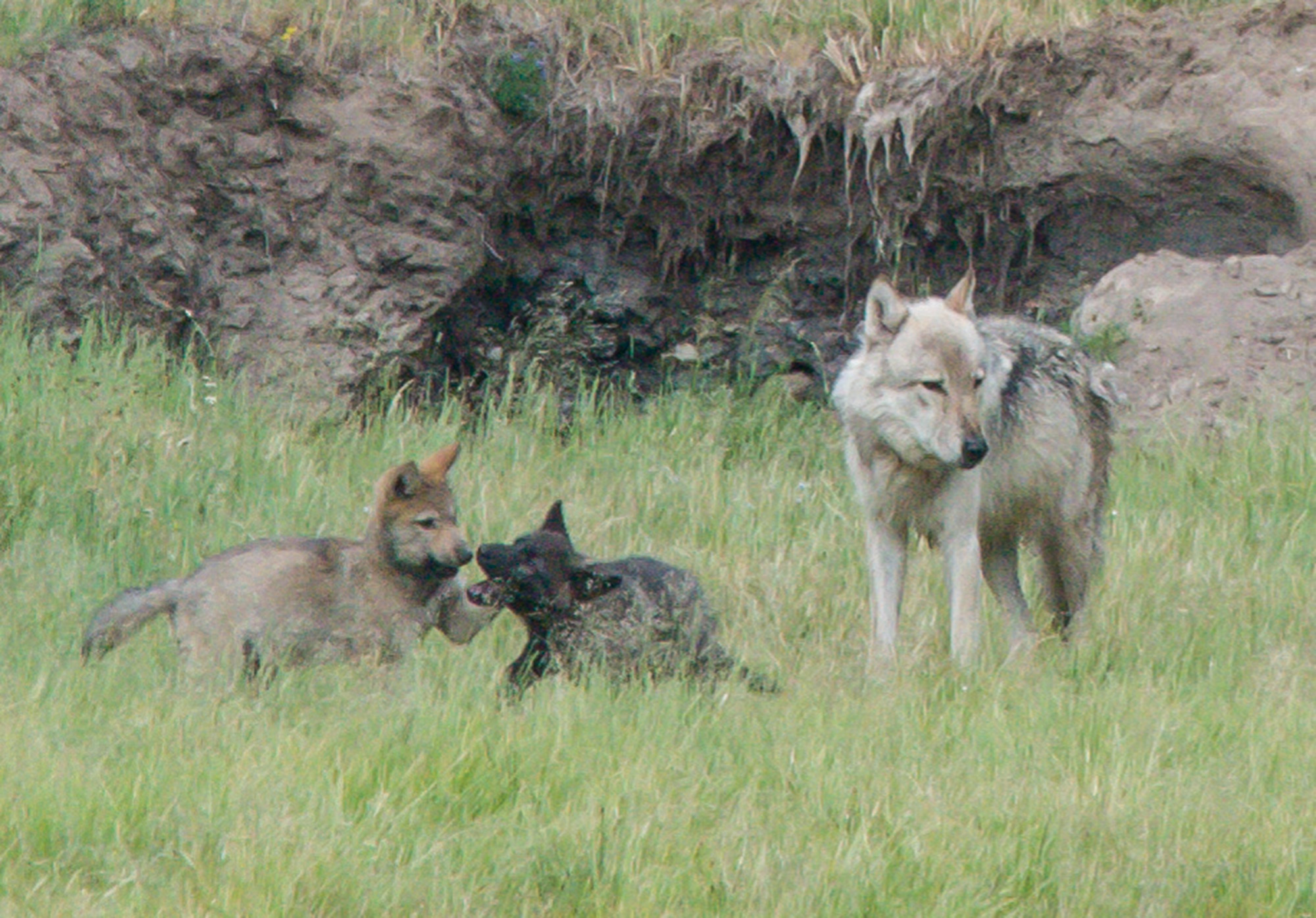
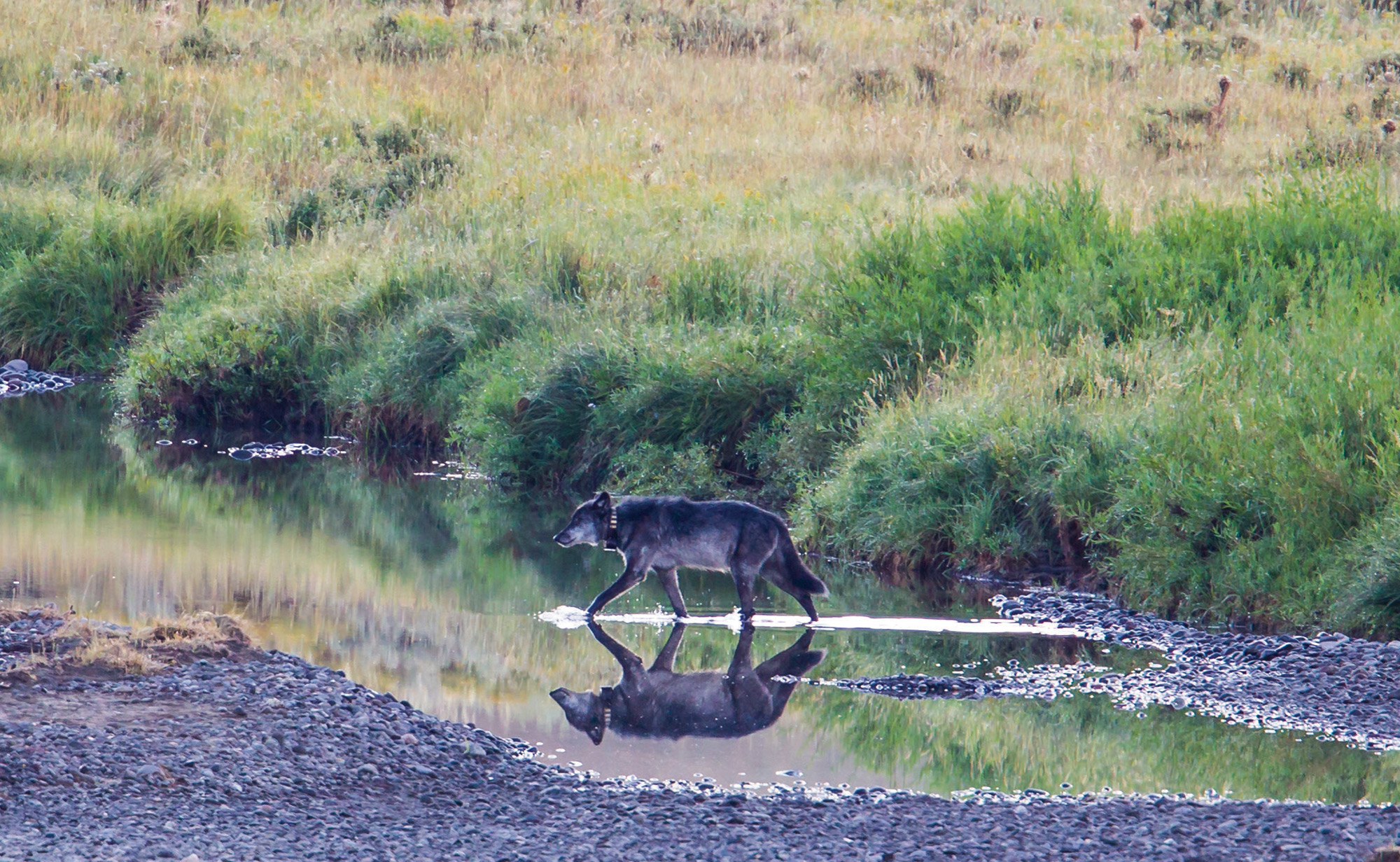
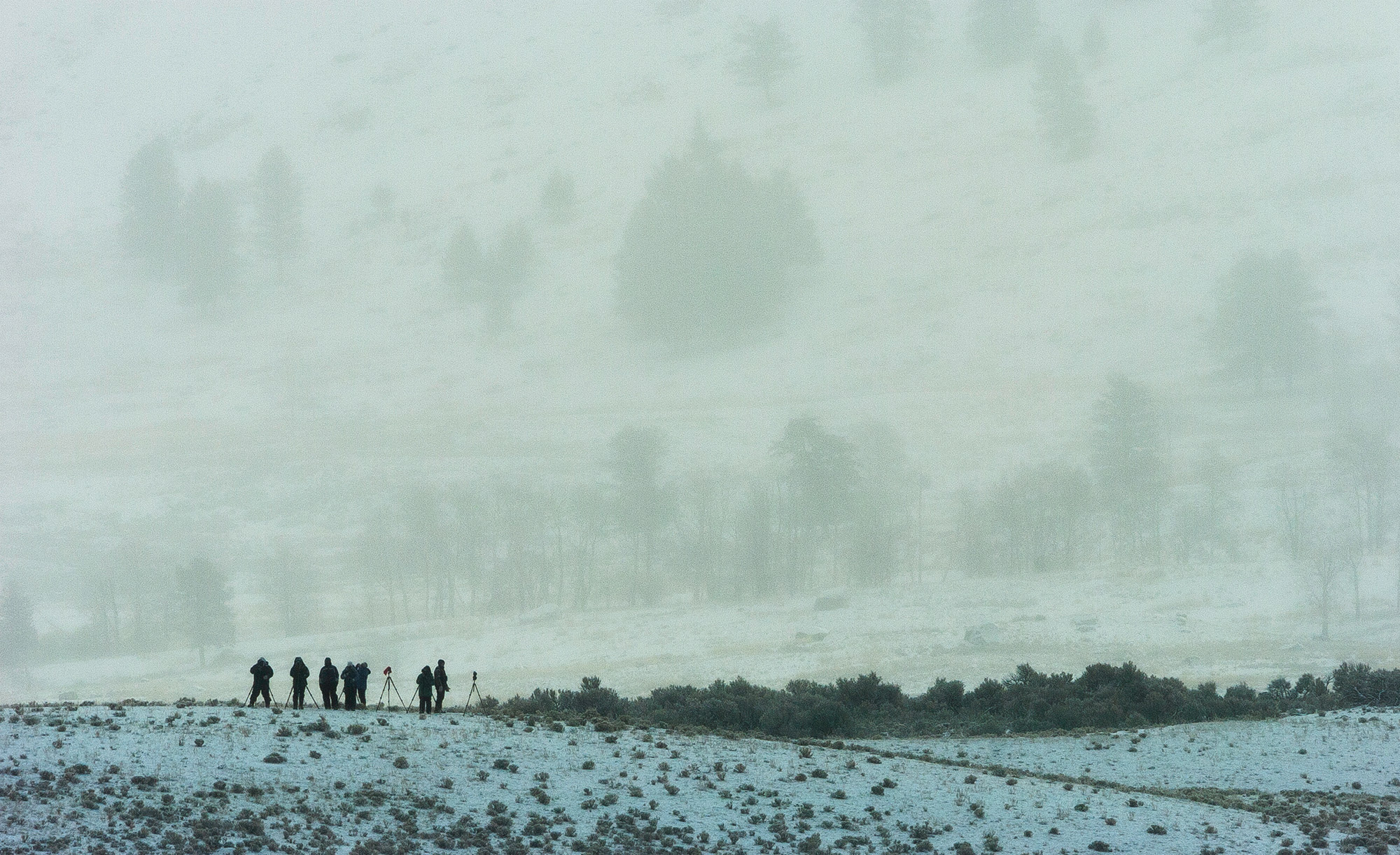
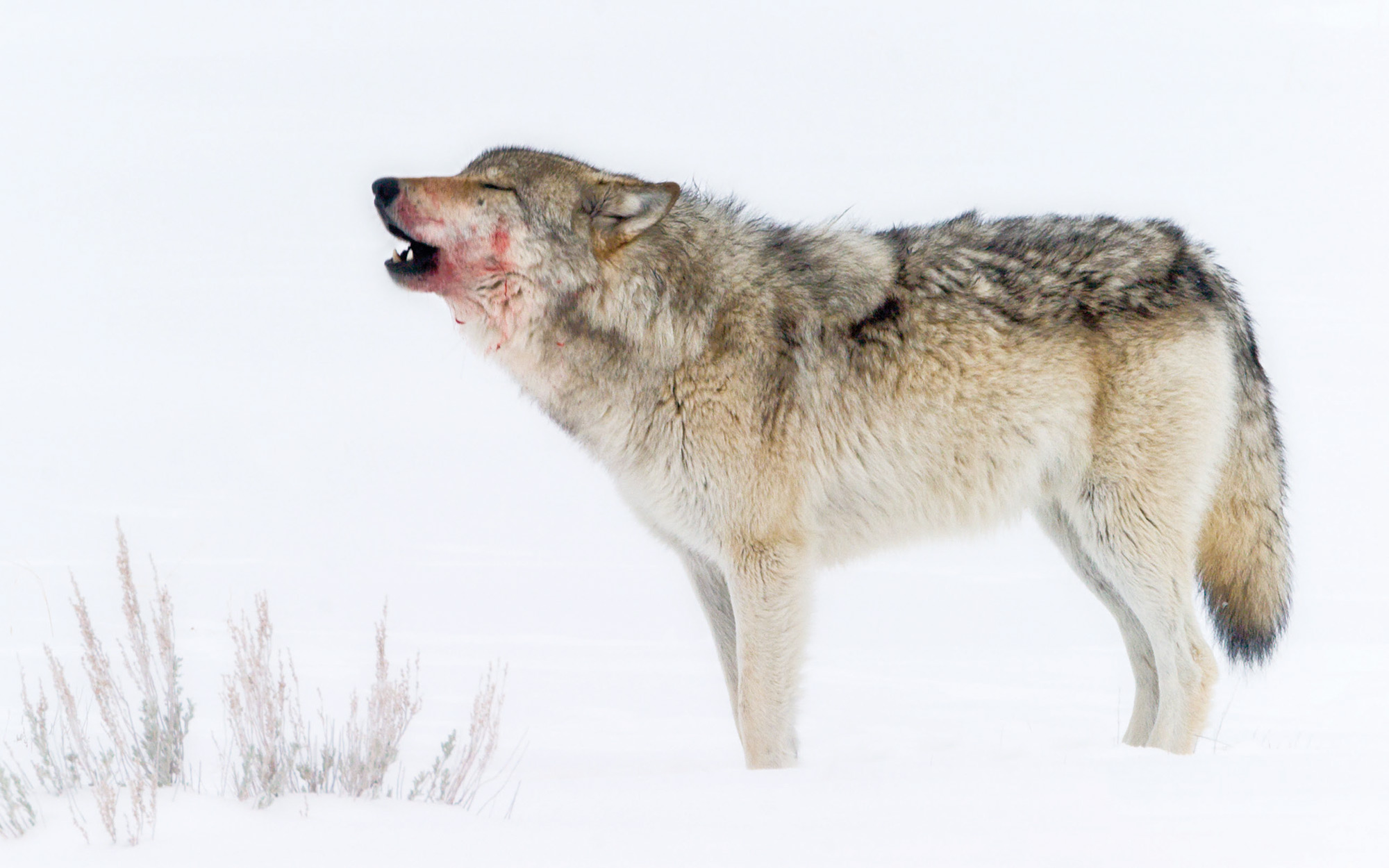
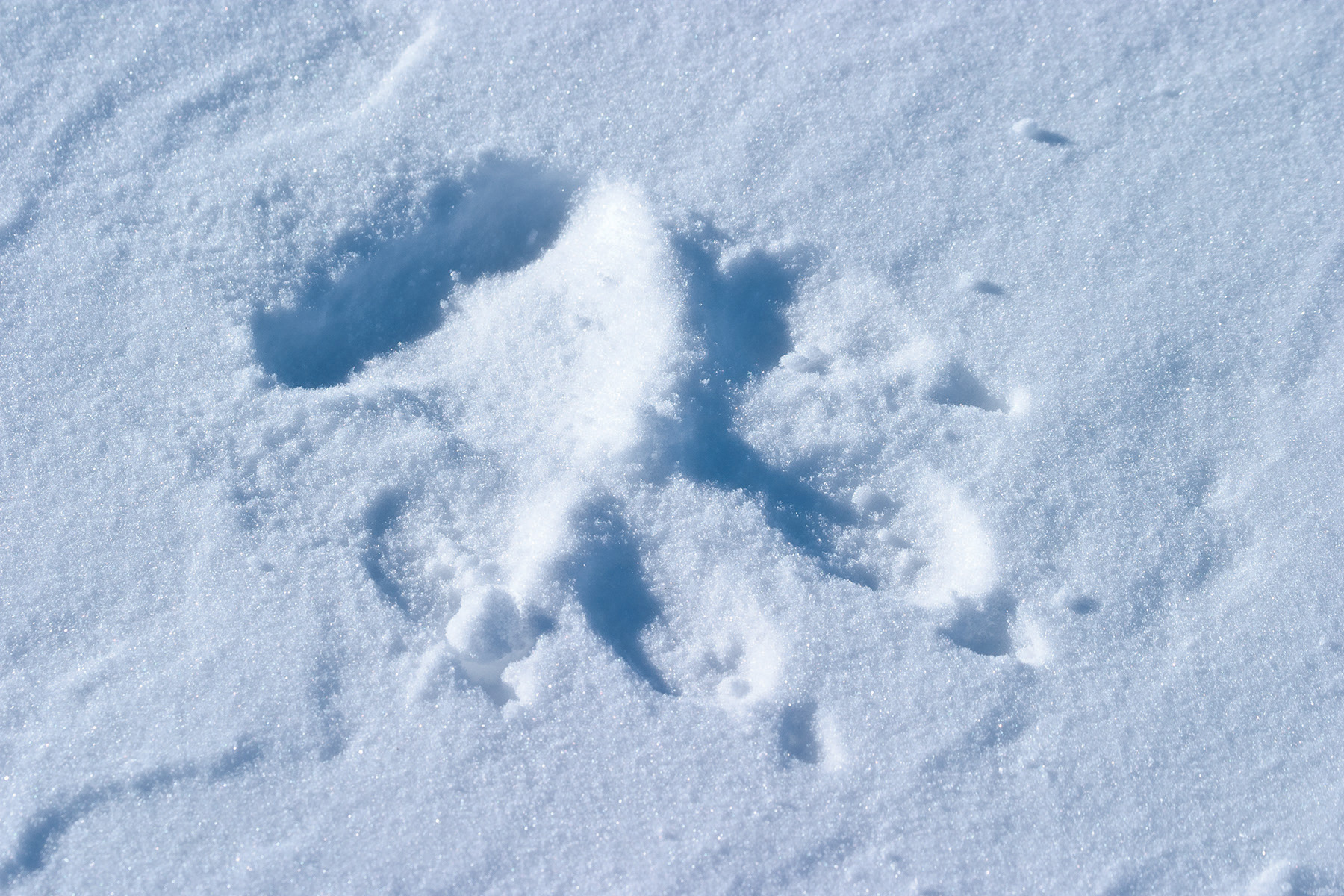
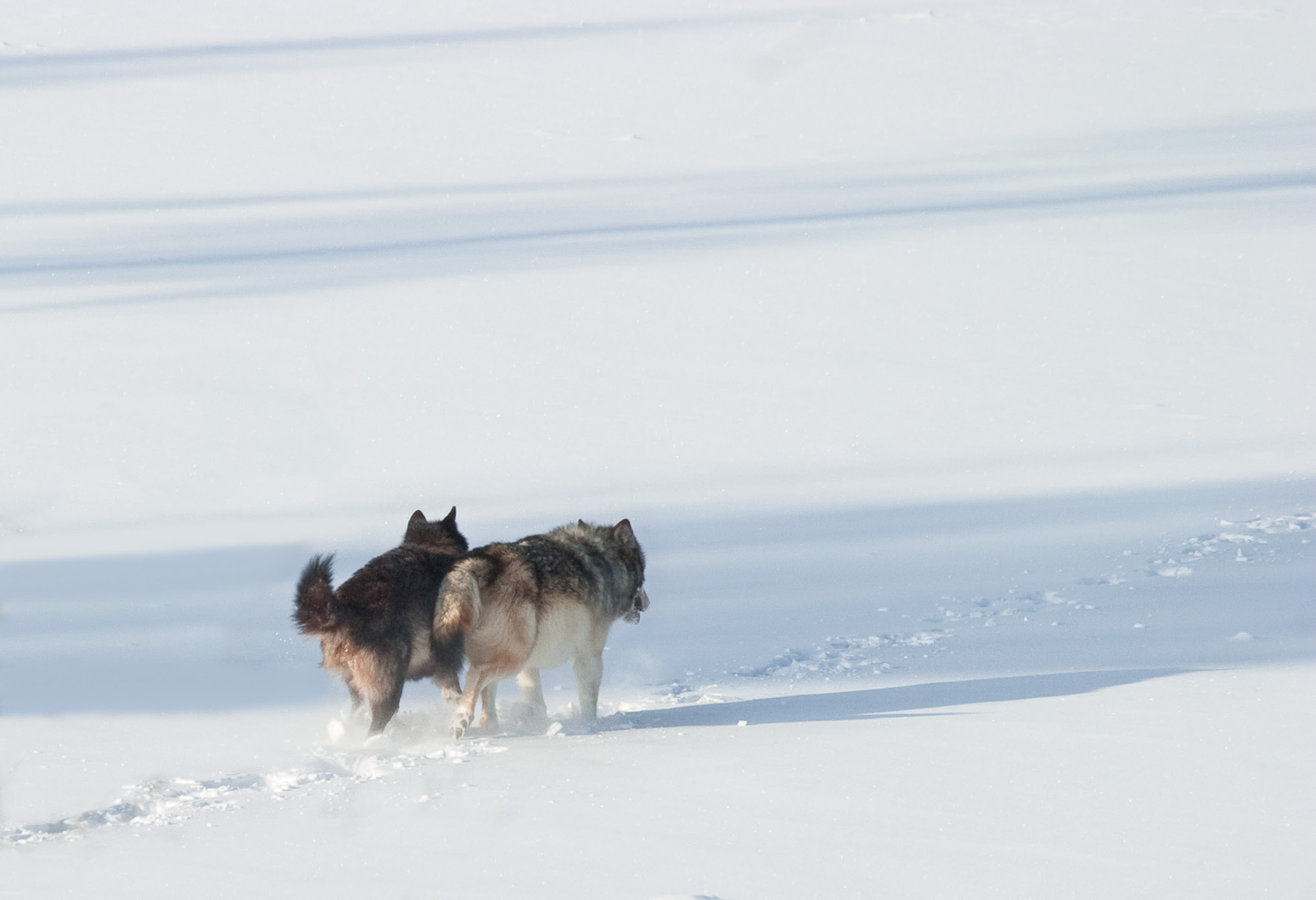
William Vogel
Posted at 19:35h, 24 MarchAny chance I could get a copy of the article? email address of the author? Thanks